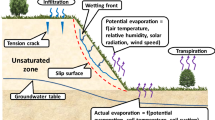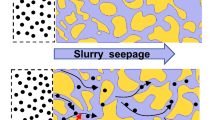Abstract
Research on the seepage deformation of saturated soft soil has resulted in many achievements based, mainly, on existing seepage-deformation control equations. In reality, however, these control equations and related parameters suffer from many problems. The conductivity coefficient in the seepage control equation and the consolidation coefficient in the consolidation equation clearly resemble each other in form. However, in existing regulations and practice, soil deformation is rarely calculated by substituting the conductivity coefficient obtained from field hydrogeological experiments for the consolidation coefficient. Similarly, seepage is seldom calculated by substituting the conductivity coefficient with the consolidation coefficient obtained from consolidation experiments. This can be attributed to the fact that the two coefficients have some obvious differences. Moreover, the settlement deformation of soil calculated using the existing seepage and consolidation models does not agree very well with the measured deformation. Also, the values calculated using different models usually deviate markedly. Research indicates that these problems derive from the fact that the seepage and consolidation equations are based on different concepts of elementary volume. This study proposes using two separate elementary volume concepts: deformation elementary volume and control elementary volume. The concepts are adopted for saturated soft soil and the results used to analyze the relationships and differences between the two concepts. Moreover, we developed a conceptual data model (CDM) for the water released from and the deformation of the saturated soil. The model discloses the differences between the consolidation and conductivity coefficients both in their physical significances and magnitudes. The inter-relationship between the two coefficients is also revealed. An analytical solution for the deformation and water released from saturated soft soil is deduced based on the CDM model and the relationship between the hydrogeological and consolidation deformation parameters is established. A physical test model for saturated soft soil under certain conditions is also designed to verify the analytical solution using a method of curve fitting. Seepage and deformation tests and case studies show that the parameters calculated using the consolidation model are in agreement with those obtained from the CDM seepage model based on the measured data for flux and settlement vs. time. Furthermore, the relationship between conductivity and consolidation coefficients is verified. The method suggested in this paper is generally applicable to problems involving the consolidation coefficient, volume compressibility, conductivity coefficient, hydraulic conductivity, and specific storage of saturated soft soil, etc. Thus, its potential applications are numerous.







Similar content being viewed by others
References
Amer AM, Awad AA (1974) Permeability of cohesionless soils. J Geotech Geoenviron Eng 100:1309–1316
Arulrajah A, Bo MW, Piratheepan J, Disfani MM (2011) In situ testing of soft soil at a case study site with the self-boring pressuremeter. Geotech Test J 34(4):355–363
Barlow JRB, Kingsbury JA, Coupe RH (2012) Changes in shallow groundwater quality beneath recently urbanized areas in the memphis, tennessee area. J Am Water Resour Assoc 48(2):336–354
Bear J (1972) Dynamics of fluids in porous media. American Elsevier Publishing Company Inc, New York
Bragov AM, Lomunov AK, Sergeichev IV, Tsembelis K, Proud WG (2008) Determination of physicomechanical properties of soft soils from medium to high strain rates. Int J Impact Eng 35(9):967–976
Chen YL, Azzam R, Wang M, Xu S, Chang LQ (2011) The uniaxial compressive and tensile tests of frozen saturated clay in Shanghai area. Environ Earth Sci 64:29–36. doi:10.1007/s12665-010-0813-y
Cui ZD, Tang YQ, Yan XX (2010) Centrifuge modeling of land subsidence caused by the high-rise building group in the soft soil area. Environ Earth Sci 59:1819–1826. doi:10.1007/s12665-009-0163-9
Gambolati G, Freeze RA (1973) Mathematical simulation of the subsidence of Venice: 1. Theory. Water Resour Res 9(3):721–733
Gambolati G, Gatto P, Freeze RA (1974) Mathematical simulation of the subsidence of venice-2. Water Resour Res 10(3):563–577
Hibbs BJ, Sharp JM (2012) Hydrogeological impacts of urbanization. Environ Eng Geosci 18(1):3–24
His JP, Carter JP, Small JC (1994) Surface subsidence and drawdown of the water table due to pumping. Geotechnique 44(3):381–396
Holden JT (1993) Consolidation of clay using vertical drains. Mathematical Eng Ind 4(2):107–116
Hu YY (2010) Long-term settlement of soft subsoil clay under rectangular or semi-sinusoidal repeated loading of low amplitude. Can Geotech J 47(11):1259–1270
Kabir MG, Lutenegger AJ (1990) In situ estimation of the coefficient of consolidation in clays. Can Geotech J 27(1):58–67
Moo-Young HT, Myers B, Tardy R, Ledbetter W (2003) Centrifuge simulation of the consolidation characteristics of capped marine sediment beds. Eng Geol 70(3):249–258
Peters GP, Smith DW (2002) Solute transport through a deforming porous medium. Int J Numer Anal Methods Geomech 26(7):683–717
Qian JH, Yin ZZ (1996) The earthwork principle and calculation. China Water Conservancy and Electricity Press, Beijing
Ren XW, Tang YQ, Xu YQ, Wang YD, Zhang X, Liu S (2011) Study on dynamic response of saturated soft clay under the subway vibration loading I: instantaneous dynamic response. Environ Earth Sci 64:1875–1883. doi:10.1007/s12665-011-1000-5
Root TL, Gotkowitz MB, Bahr JM, Attig JW (2010) Arsenic geochemistry and hydrostratigraphy in midwestern U.S. glacial deposits. Ground Water 48(6):903–912
Selonen SM, Liiri R, Setala H (2012) The fate of lead at abandoned and active shooting ranges in a boreal pine forest. Environ Toxicol Chem 31(12):2771–2779
Shen SL, Xu YS, Hong ZS (2006) Estimation of land subsidence based on groundwater flow model. Mar Georesour Geotechnol 24(2):149–167
Short M, Higdon D, Guadagnini L, Guadagnini A, Tartakovsky DM (2010) Predicting vertical connectivity within an aquifer system. Bayesian Anal 5(3):557–581
Su MB, Su CL, Chang CJ, Chen YJ (1998) A numerical model of ground deformation induced by single well pumping. Comput Geotech 23(1):39–60
Xu JC, Xu YW (2011) Grey correlation-hierarchical analysis for metro-caused settlement. Environ Earth Sci 64:1249–1256. doi:10.1007/s12665-011-0940-0
Xue YQ (1997) Groundwater dynamics, 2nd edn. Geological Publishing House, Beijing
Yin JH, Tong F (2011) Constitutive modeling of time-dependent stress-strain behaviour of saturated soils exhibiting both creep and swelling. Can Geotech J 48(12):1870–1885
Zhou ZF, Guo QN, Dou Z (2013) Delayed drainage of aquitard in response to sudden change in groundwater level in adjacent confined aquifer: analytical and experimental studies. Chin Sci Bull 58(25):3060–3069. doi:10.1007/s11434-013-5730-5
Acknowledgments
This study was supported financially by the National Natural Science Foundation of China (Grant Nos. 41172204, 51079043), the Natural Science Foundation of Jiangsu Province (Grant No. BK2012814), and the Program for Excellent Innovation Talents in Hohai University.
Author information
Authors and Affiliations
Corresponding author
Rights and permissions
About this article
Cite this article
Zhou, Z., Wang, J., Huang, Y. et al. Conceptual data model and method of settlement calculation for deformation and water release from saturated soft soil. Environ Earth Sci 71, 4235–4245 (2014). https://doi.org/10.1007/s12665-013-2818-9
Received:
Accepted:
Published:
Issue Date:
DOI: https://doi.org/10.1007/s12665-013-2818-9




